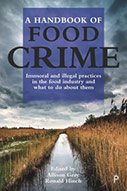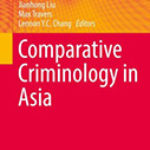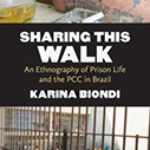A Handbook Of Food Crime: Immoral And Illegal Practices In The Food Industry And What To Do About Them

Editors: Allison Gray and Ronald Hinch
Publisher: Bristol, UK: Policy Press, 2018. 384p.
Reviewers: Jon Davies and Nicholas Lord │ July 2020
Scientific and policy interest in the concept of ‘food crimes’ has started to gain traction in recent years as major cases, such as the horsemeat and fipronil scandals in Europe, have impacted upon the integrity and robustness of the global food system. Consumer trust and confidence in food has also been affected by these developments, which have drawn attention to an array of criminal, unlawful and immoral practices within the food industry. A Handbook of Food Crime seeks to build on this growing area of research by providing a number of concise yet informative chapters and case studies of contemporary issues related to food crime, and more notably the array of harms associated with food industry practices and ways of operating. In these terms, the editors seek to turn ‘a criminological gaze on the conditions under which food is (un)regulated and (poorly) enforced’ and foreground the ‘problematic conditions under which food (dis)connects with humanity and its consequences on public health and wellbeing, non-human animals and the environment, often simultaneously’ (p.7). There is not much ‘criminology’ per se in the book as a whole, bar a few contributions, but rather a series of commentaries and essays from contributors with interests in food working in other disciplines that seek to illuminate practices that are, or should be, considered ‘crimes’ given their social harms.
The editors are keen to put forward their preference for moving analyses of food crimes away from only those behaviours defined as criminal, to incorporate ways of behaving that involve ‘illegal, criminal, harmful, unjust, unethical or immoral food-related issues’ (Gray, p. 12). As Aubert (1952: 266) once stated in relation to the ambiguities of white-collar crimes, the ‘problem’ cannot be solved by attempting to categorise them as ‘crimes’ or ‘not crimes’; it is their ambiguous, contested and controversial nature that makes them sociologically interesting. As this book seeks to point out, there are myriad direct and indirect harms associated with food production, distribution and consumption, that may or may not be formally criminal, but that impact upon large populations of society negatively e.g. slavery (Ch. 5), obesity (Ch.7) or salmonella poisoning (Ch. 11), to name but a few. However, any given explanation or account needs to be clear about the boundaries and parameters of what is being analysed and explained, and this book leaves unresolved (perhaps for good reason), what the parameters of a ‘harm perspective’ should or could be, or how researchers, policymakers or practitioners might operationalise this broader framing for empirical research or policy interventions (cf. Greenfield and Paoli, 2013; Davies, 2018). Instead, it aims to promote a ‘critical’ view of deviance and harm in the food system and the interconnections with the current political economy i.e. seeing neo-liberalism as generative of many of these harms.
The book represents a positive example of how researchers at varying stages of their careers, and from numerous disciplines, can contribute to existing discussions on food crime. Importantly, the book solidifies the well-grounded assertion that challenges of food crime and harm are best addressed ‘through an interdisciplinary marriage founded on matters involving food’ (p. 2); it is difficult to disagree with this, but the collection here reflects a multi-disciplinary, rather than inter-disciplinary, approach. For a truly interdisciplinary analysis, these different disciplines need to be brought into direct dialogue with a view to iterative and deliberative accounts of crime and harm in the food system, and how these should be addressed. Nonetheless, the book contains varied contributions from criminology, sociology, law, geography, political science, and healthcare perspectives, among many others, that each offer useful insights into this area.
The book is structured by way of eight sections, each of which contains three chapters written by different authors with expertise in their respective areas. The first section, ‘Thinking about food crime’, frames the issue of food crime from criminological perspectives, including ways in which perceptions of legal and illegal behaviours can become blurred. The book signposts an underpinning theoretical perspective of social harm, by arguing that legal frameworks and regulatory oversight do not sufficiently address existing problems of food crime. As a result, labelling all activities associated with food crime as ‘criminal’, and relying solely on criminal justice system interventions is problematic. In this context, the social harm approach provides an alternative lens through which to consider harmful actions and omissions against consumers, workers, businesses, animals, and the wider public throughout the global food industry. There is not necessarily a call for ‘abandoning’ criminology in favour of social harm here, but the advantages of a social harm approach are recognised when conceptualising food crime. Many authors in the collection refer back to this approach, albeit sometimes implicitly. The tension between ‘crime’ and ‘harm’ is becoming an increasingly important issue when challenging the traditional boundaries of criminology, especially as a wider range of state-corporate facilitated harms throughout otherwise legitimate industries becomes apparent.
Section two moves on to discuss food crime in relation to farming and food production stages. This includes a consideration of ethical challenges faced by farmers, who as producers face unique problems associated with the physical environment, such as extreme temperatures and seasonality, whereby decisions made could result in food crime. A range of other pressures, including organisational decision-making, the actions of other farmers, and financial considerations, may encourage some farmers to pursue unethical practices. As part of farming practices, the issue of slavery in relation to cocoa production and child labour is provided, from both an historical and contemporary perspective. The impact of hazardous substances on farmers is included as part of the emphasis on the farming stage of supply chains.
Moving on from farming practices, section three is concerned with food processing, marketing and accessing food. Issues revolving around obesity and access to food, the role of product sampling in mitigating against food adulteration, and the built environment as providing access to healthier food options, are all considered. While at first glance, some of these discussions may seem removed from the immediate context of food crime, they provide a useful lens through which to consider the broader area of the food industry, and ultimately, where the opportunities for food crime are likely to be strongest. In particular, reference is made to the notions of food ‘deserts’, ‘swamps’ and ‘mirages’ regarding how segments of the population have access (or not) to nutritious food and affordable food. Considering such concepts provides a useful background understanding of where the demand for certain types of food originates from, and how this may differ geographically and based on other socio-economic factors, including inequality.
Section four is primarily concerned with the role of corporations and the regulatory context in facilitating food crime, especially within the context of ‘cheap’ capitalism with regards to business morality, use of low-wage labour, and unsafe goods in maximising profit levels. Therefore, this section begins to consider factors inherent to organisations and the wider political-economic context in order to explain how opportunities for food crime may develop. Key themes in this section include a lack of consensus at the legal-policy level on provisions to tackle food crime, the notion of state-corporate crime as a combination of harmful corporate actions coupled with poor state oversight, as well as the strategic challenges that businesses face when simultaneously reducing costs and adhering to legal requirements.
The issues of food trade and movement are the focal point of analysis in section five, including a harm-based perspective on animal transportation, regulatory networks in the EU, and the role of fair-trade ethics. The treatment of animals is placed at the forefront of discussion as part of this harm perspective, thereby moving away from the usual emphasis of food production impacts on humans. Since the mistreatment of animals in food production has traditionally been overlooked in comparison to other harms in this sphere, such a discussion provides a welcome addition to the collection.
Section six elaborates on various technological features and processes that can contribute to food crime. In particular, part of this section refers to Croall’s work on food crime, who was among one of the earlier criminologists to highlight the harms of food production. In particular, the argument is made that that neoliberalism is the dominant ideology of the Western food system, and that the economic context of the system is criminogenic, since it encourages a culture where profits are prioritised to the extent that deviant corporate behaviour is normalised. In other words, harms are not simply unfortunate by-products of food production, but central to it and are the ‘cost of doing business’.
Section seven considers a number of factors related to ‘green food’, including contemporary challenges such as climate change, food waste, and children’s diets. Here, a range of potential harms are signposted, including the consequences of mass production on the environment, the ways in which food waste affects poorer communities, and the ways in which children are particular vulnerable to nutrient-deficient food. The section moves beyond the specific issue of food crime by explaining how capitalist processes associated with production can serve as precursors for food crime to occur.
The final main section discusses the role of consumers in perceiving corporate wrongdoing within the food system, including ‘food democracy’, consumer reactions to food safety scandals, and key responses to food crime such as the personal choices that consumers make. Traditionally, researchers have used well-known phrases such as ‘the consumer is king’ in order to help explain how consumer reaction to corporate scandals may serve as a form of external pressure on business decision making; with the caveat that some consumers may be susceptible to advertising campaigns of large multi-national firms. Here, a detailed discussion is provided of key factors that consumers may consider when they become aware of food safety scandals, and whether or not to take their business elsewhere. These factors include allocation of blame to companies or governments; the frequency of scandals; as well as to what extent consumers feel the company can resolve the problem themselves without external oversight. Such considerations integrate well with wider discussions of self-regulation in this sphere.
One of the book’s advantages is that it moves beyond the immediate challenges associated with food crime, and considers a broader range of harms within the global agri-food industry, including labour exploitation, health and safety concerns, nutrition, as well as the treatment of non-human animals. In this context, parts of the book begin to move towards a ‘post-humanist’ stance, whereby the role of humans becomes subject to greater scrutiny when considering potential impacts on animals and the natural environment more broadly. However, since humans are the dominant actors in food chains, issues that directly affect humans seem to remain at the centre of attention in most research outputs. While these broader factors may, at first glance, seem to divert attention from key processes and technical explanations of factors typically linked to food crime such as adulteration, they provide helpful backdrops that may indirectly contribute to the conditions necessary for food crime to occur. The book therefore provides helpful snapshots of various criminal and/or ethically dubious processes within local, national and global food systems. Those with an interest in one or more of these spheres will undoubtedly find this collection useful.
Dr. Jon Davies, Research Fellow, Faculty of Law, Tel Aviv University
Dr. Nicholas Lord, Reader in Criminology, School of Law, The University of Manchester


